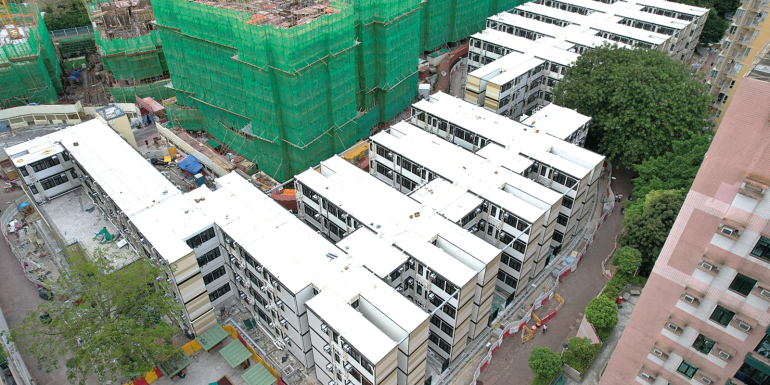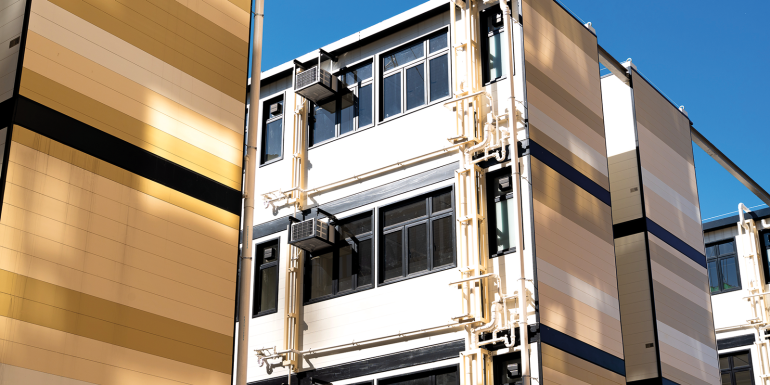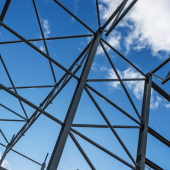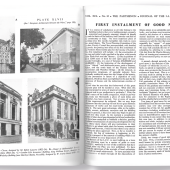Streamlined digital services for modular building

CABE Built Environment 2024 winner CR Construction Company’s MiC projects are a glimpse of the future.
Even people with only a cursory knowledge of Hong Kong will be aware that the region faces some unique issues when it comes to the built environment. For example, with 7.5 million inhabitants occupying a land mass of 1,100 square kilometres (426 square miles), it is the fourth most densely populated area in the world. That means building engineers working in Hong Kong often have to resort to innovation. Step forward Hong Kong’s CR Construction Company, which won the CABE Built Environment 2024 award for its transitional housing project at Hung Shui Kiu, Yan Oi House.
To address the need for transitional housing in Hong Kong while championing sustainability and efficiency on a constrained urban site, CR Construction used a combination of technologies including building information modelling (BIM), the company’s own SmarTick Pro app and cloud-based technology. The two four-storey buildings were made using 440 Modular Integrated Construction (MiC) modules and were built in just 320 days.
Housing is one of the issues that causes the most concern in Hong Kong society, with hundreds of thousands of people waiting years to obtain a unit of public housing. Consequently, Hong Kong government policy is to reduce construction time. “Modular construction was first started in Singapore and this method aims to shorten the construction cycle,” CR Construction’s Assistant Building Services Manager Wilson Lee explains.
“Hong Kong has seen the success of modular construction in Singapore and has chosen to adopt it here. You can think of it as a Lego building method. All the flats in a residential building are identical in terms of size and layout because they are built and duplicated in an off-site factory, module by module, and then transported for final assembly on-site.
“There is often much confusion over the difference between MiC and pre-fabrication construction methods, yet they have certain similarities. Pre-fabrication generally refers to off-site factory pre-construction of components of works, while MiC refers to the complete off-site factory pre-construction of volumetric modules of buildings with all finishes, building services and even furniture.”
Going digital
Some parts of a building – such as the plant room – are not suitable for off-site construction and do not need to be duplicable so are built on-site. Other repeatable items can be built in an off-site factory, resulting in the construction time being significantly shortened.
In the case of the transitional housing project at Hung Shui Kiu, the MiC elements of the build were co-ordinated and augmented by the use of breakthrough digital technologies. An important ingredient was the use of CR Construction’s ISO27001-certified (for security) self-developed digital works supervision system, accessed via its proprietary SmarTick Pro app.
To enhance communication and collaboration among project members, SmarTick Pro served as a centralised platform for information sharing, task management and issue tracking. It allowed real-time access to project data and helped with decision-making, significantly improving project co-ordination and communication across teams.
“Imagine on your Apple or Android phone screen you could find all the functions in one place – that is the same concept as our centralised management platform accessed via SmarTick Pro,” Lee says. “We put the BIM and quality control, with the support of a cloud-based network, all in one platform. When you click into the mobile app, you can check the off-site modular fabrication progress and, at the same time, compare the accuracy of size or dimensions in the BIM.
“We utilised BIM as a digital technology to integrate the entire project life-cycle, from design and construction to operation. BIM allowed us to create a detailed virtual model of the project, enabling accurate visualisation, clash detection and co-ordination among various disciplines. This digital tool facilitated effective communication, reduced errors and optimised construction sequencing.”

Signs of success
Building in Hong Kong faces some unique obstacles; however, other challenges – such as building to budget – are universal. Lee is candid about the role SmarTick Pro played in reducing costs. “There are alternatives to SmarTick Pro when it comes to smart site apps in Hong Kong and some of them might even be better. But what does success mean for a construction company?
“You can say: helping the construction industry to improve, or completing a building on time. But I would say success is also profit. If a construction company cannot survive financially, how can it do more to help the construction industry? So that is why we created our app: simply because of cost control.”
Of course, there are other measures of success. By utilising MiC, CR Construction was able to significantly reduce construction time compared to traditional methods, which had the knock-on benefits of accelerating the availability of the housing – and minimising disruption to the surrounding community. That was particularly impressive given the period in which the project was undertaken.
“We built it during the time of Covid-19. Since all of the modular components were fabricated in mainland China, both the progress and quality of the components could not be monitored first-hand because of lockdown. This is why the use of a cloud-based platform helped us to remotely monitor the manufacturing process and, as a result, complete the building promptly and in good condition.”
The project also aligned with Hong Kong’s Construction 2.0 era, which emphasises sustainable practices. MiC reduces construction waste, minimises energy consumption and promotes the use of sustainable materials. This, Lee says, contributed to the project having a smaller carbon footprint and a more environmentally friendly approach to construction.
“To promote sustainability, we incorporated innovative materials and technologies. This included the use of eco-friendly building materials such as low-emission concrete, recycled steel and sustainable insulation materials. Additionally, we integrated renewable energy systems, such as energy-efficient lighting, to reduce energy consumption and minimise the project’s carbon footprint.”
Lee notes that all of these measures mean that efficiency and sustainability were improved; advanced safety systems – including real-time monitoring and analytics and Internet of Things-enabled safety equipment – mean that safety was improved; and, by ensuring a quality-controlled indoor atmosphere, it has resulted in a significantly better living experience for the buildings’ occupants.
Lee says: “With this project, we aimed to deliver public benefit by addressing housing needs; drive innovation through digital transformation; improve productivity by leveraging advanced technologies; enhance user wellbeing through safety and comfort; and support positive change in the construction industry by promoting a culture of efficiency, sustainability and safety. We think we have achieved all of that.”
For more, visit cr-construction.com.hk
Image credit | CR Construction Company







